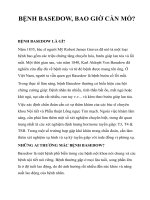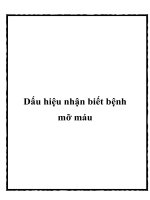LCH protocol Bệnh mô bào
Bạn đang xem bản rút gọn của tài liệu. Xem và tải ngay bản đầy đủ của tài liệu tại đây (384 KB, 56 trang )
LCH - III
(2nd Version: January 2002)
Treatment Protocol of the
Third International Study
for
LANGERHANSCELL HISTIOCYTOSIS
START OF THE STUDY: April 2001
STUDY REFER CENTER
Gadner Helmut, MD, chairman
Grois Nicole, MD, study coordinator
Minkov Milen, MD, study coordinator
Pötschger Ulrike, MSc, statistician
Thiem Elfriede, data manager
St. Anna Children’s Hospital
Kinderspitalgasse 6
A -1090 Vienna, Austria
Tel.:
(43-1)-40170/250 (H. Gadner)
(43-1)-40170/476 (LCH - office)
Fax:
(43-1)-40170/430
E-mail:
STUDY SUBCENTERS
STUDY COORDINATORS
Argentina
Braier Jorge, MD
Austria, Germany, Netherlands, Switzerland
Gadner Helmut, MD,
Grois Nicole, MD,
Minkov Milen, MD,
Canada
Weitzman Sheila, MD
France
Donadieu Jean, MD, Ph.D.
Great Britain, Ireland
Windebank Kevin, MD
Italy
Arico Maurizio, MD
Scandinavia
Henter Jan-Inge, MD
U.S.A.
McClain Ken, MD
2
PATHOLOGY REFERENCE CENTER
Jaffe Ron, MD, head of the pathologist’s panel
Regional Pathology Centers
Local Pathology Coordinators
Austria
Simonitsch Ingrid, MD
Argentina
Goldberg Julio, MD
France
Emile Jean Francoise MD, Ph.D.
Germany
Harms Dieter, MD, Schmidt Dieter, MD
Italy
Paulli Marco, MD
Scandinavia
Abiel Orrego, MD
U.S.A.
Jaffe Ron, MD
DATA SAFETY MONITORING BOARD
Faldum Andreas, Ph.D., statistician
Michaelis Jörg, Ph.D., statistician
Otten Jaques, MD, clincian
Tubergan David, MD, clinician
STUDY COMMITTEE
Arico, Maurizio
Pavia
Italy
Braier, Jorge
Buenos Aires
Argentina
Donadieu, Jean
Paris
France
Gadner, Helmut
Vienna
Austria
Henter, Jan-Inge
Stockholm
Sweden
Janka-Schaub, Gritta
Hamburg
Germany
Komp, Diane
New Haven
USA
Ladisch, Stephan
Washington D.C.
USA
McClain, Kenneth
Houston
USA
Weitzmann, Sheila
Toronto
Canada
Windebank, Kevin
Newcastle upon Tyne
Great Britain
3
TABLE OF CONTENTS
1
ADDRESSES..................................................................................................... 6
2
BACKGROUND............................................................................................... 12
2.1
CONCLUSIONS OF LCH II.............................................................................. 19
2.2
RATIONALE FOR THE USE OF METHOTREXATE IN “RISK” PATIENTS..... 20
2.3
SITUATION IN PATIENTS WITH MULTIFOCAL BONE DISEASE AND
“SPECIAL SITES” OF DISEASE...................................................................... 20
3
PATIENT’S ELIGIBILITY FOR LCH III ............................................................ 22
4
LCH III STUDY REQUIREMENTS................................................................... 22
4.1
HISTOPATHOLOGICAL DIAGNOSTIC CRITERIA ......................................... 22
4.2
BASELINE DIAGNOSTIC EVALUATIONS ...................................................... 23
4.3
EVALUATIONS REQUIRED UPON SPECIFIC INDICATION.......................... 24
4.4
DEFINITION OF ORGAN INVOLVEMENT ...................................................... 25
5
STRATIFICATION ........................................................................................... 26
5.1
GROUP 1 - MULTISYSTEM “RISK” PATIENTS .............................................. 26
5.2
GROUP 2 - MULTISYSTEM “LOW RISK” PATIENTS .................................... 26
5.3
GROUP 3 - SINGLE SYSTEM “MULTIFOCAL BONE DISEASE” and
LOCALIZED “SPECIAL SITE” INVOLVEMENT ............................................... 27
6
GOALS FOR LCH III ...................................................................................... 27
6.1
Group 1: MULTISYSTEM “RISK” Patients ....................................................... 27
6.2
Group 2: MULTISYSTEM “LOW RISK” Patients .............................................. 28
6.3
GROUP 3: SINGLE SYSTEM MULTIFOCAL BONE and LOCALIZED
“SPECIAL SITES” ............................................................................................ 28
7
STUDY DESIGN .............................................................................................. 28
8
REGISTRATION AND RANDOMIZATION ...................................................... 29
8.1
REGISTRATION .............................................................................................. 29
4
8.2
9
RANDOMISATION........................................................................................... 29
TREATMENT ................................................................................................... 29
9.1
GROUP 1: MULTISYSTEM “RISK” PATIENTS .............................................. 29
9.2
GROUP 2: “LOW RISK” GROUP ..................................................................... 32
9.3
GROUP 3: “MULTIFOCAL BONE DISEASE” AND “SPECIAL SITES” ............ 33
9.4
SUPPORTIVE CARE GUIDELINES ................................................................ 33
9.5
TOXICITY......................................................................................................... 34
9.6
Therapy modifications ...................................................................................... 35
10
ASSESSMENT OF TREATMENT RESPONSE............................................... 37
10.1 DEFINITION OF DISEASE STATE.................................................................. 37
10.2 DEFINITION OF RESPONSE CRITERIA ........................................................ 37
10.3 RESPONSE EVALUATION.............................................................................. 38
11
OFF STUDY CRITERIA ................................................................................... 41
12
AUTOPSY........................................................................................................ 41
13
FOLLOW UP INVESTIGATIONS AFTER STOP OF THERAPY..................... 42
14
DATA COLLECTION AND EVALUATION ...................................................... 43
15
DATA SAFETY MONITORING BOARD (DSMB)............................................ 44
16
STATISTICAL CONSIDERATIONS ................................................................ 44
16.1 DESIGN ........................................................................................................... 45
16.2 ENDPOINTS .................................................................................................... 45
16.3 ANALYSES ...................................................................................................... 47
16.4 INTERIM-ANALYSES ...................................................................................... 49
16.5 POWER CONSIDERATION............................................................................. 51
16.6 STOPPING RULES.......................................................................................... 52
17
PUBLICATION................................................................................................. 54
18
REFERENCES................................................................................................. 54
5
1 ADDRESSES
STUDY SUBCENTERS
Study subcenter
Study coordinator
Telephone, fax, e-mail
Argentina
Jorge Braier, MD
Tel:+54 11 43084 300
Hospital Garrahan
Fax:+54 11 4308 5325
Combate de los Pozos
1881
Hematology / Oncology
Buenos Aires 1245
Argentina
Austria, Germany,
Helmut Gadner, MD,
Tel:+43-1-40170/250 (Gadner)
Netherlands,
Nicole Grois, MD
+43-1-40170/476 (LCH-office)
Switzerland
Milen Minkov, MD
Fax: +43-1-40170/430
St. Anna Children’s
Hospital
Kinderspitalgasse 6
1090 Vienna
Austria
Gritta Janka-Schaub, MD
Children´s University
Tel: +49 40 42803 4270
Fax: +49 40 42803 4601
Hospital, Dept. of
Hematology/Oncology
Martinistraße 52
20246 Hamburg
Germany
Canada
Sheila Weitzman, MD
Tel: +1 416 813 5872
Hospital for Sick Children
Fax:+1 416 813 5327
555 University Avenue
Division of Hematology /
Oncology, Toronto
ON M5G IX 8, Canada
6
Study subcenter
Study coordinator
Telephone, fax, e-mail
France
Caroline Thomas, MD
Tel: +33 2 40 0836 10
Hotel Dieu
Fax: +33 2 40 0836 08
Service de Oncologie
Pediatrique
Hospital Mere Enfant
Nantes 44000, France
Great Britain, Ireland
Kevin Windebank, MD
Tel:+44 191 2023026
Sir James Spence Institute
Fax:+44 191 2023060
The Royal Victoria Infirmary
Department of Child Health
Newcastle upon Tyne
NE1 4LP
United Kingdom
Italy
Maurizio Arico, MD
Tel :+39 091-6666 131
Ospedale dei Bambini "G. Di Fax :+39 091 6666 202
Cristina"
Onco-Ematologia Pediatrica
Via Benedettini 1
90100 Palermo, Italy
Scandinavia
Jan-Inge Henter, MD
Tel:+46 8 5177 2870
Department of Pediatrics
Fax:+46 8 5177 3184
Child Cancer Research Unit
Karolinska Hospital
S-171 76 Stockholm
Sweden
7
U.S.A
Local coordinator
Kenneth McClain, MD
Tel: +1 832 822 4208
Texas Children´s Clinical
Fax:+1 832 825 1502
CC1510.00
6621 Fannin St.
Houston, TX 77030
Office
Histiocyte Society
Tel: +1 856 589 6606
72 East Holly Ave Suite 101
Fax:+1 856 589 6614
Pitman, NJ 08071
8
PATHOLOGY PANEL
Pathology reference
center
Reference pathologist
Telephone, fax, e-mail
U.S.A
Ron Jaffe, MD
Tel.:
Children´s Hospital 2361
Fax: +1 412 692 6550
3705 Fifth Avenue
+1 412/692 5657
Pittsburgh, PA 15213
USA
Regional pathology
centers
Local pathology
coordinator
Telephone, fax, e-mail
Austria
Ingrid Simonitsch, MD
Tel: + 43 1 40400 6372
University of Vienna
Fax: + 43 1 40400 6370
Department of Pathology
ingrid.simonitsch@akh-
Währinger Gürtel 18-20
wien.ac.at
1090 Vienna
Austria
Argentina
Julio Goldberg, MD
Tel: +54 14 806 8955
Hospital de Pediatria Juan
Fax: +54 11 4824 2357
P. Garrahan
Department of Pathology
Combate de los Pozos 1881
Buenos Aires
Argentina, 1245
France
Jean Francois Emile, MD,
Tel: +33 1 4559 3291
Ph.D.
Fax:+33 1 4559 3886
Paul Brousse Hospital
Department of Pathology
hop-paris.fr
F-94804 Villejuif
France
9
Regional pathology
centers
Local pathology
coordinator
Telephone, fax, e-mail
Germany
Dieter Harms, MD
Tel: +49 431 597 3450
University of Kiel
Fax:+49 434 597 3486
Department of Pediatric
Pathology
Michaelisstraße 11
24105 Kiel, Germany
Dietmar Schmidt, MD
Tel: +49 621 2277 9
Institute of Pathology
Fax: +49 621 15328 8
A 2,2
68159 Mannheim
Germany
Italy
Marco Paulli, MD
Tel: +39 0382 501241
Istituto di Anatomia
Fax: +39 0382
Patologica
IRCCS Policlinico San
Matteo
27100 Pavia
Italy
Scandinavia
Abiel Orrego, MD
Tel: +46 8 5177 5147
Karolinska Hospital
Fax: +46 8 5177 4524
Division of Pathology and
Cytology
Paediatric section
S – 171 76 Stockholm
Sweden
10
DATA SAFETY MONITORING BOARD
Study statistician
Ulrike Pötschger, M.Sc.
Tel: +43 1 40 170 477
St. Anna Children´s Hospital
Fax: +43 1 40 170 430
Kinderspitalgasse 6
A-1090 Vienna
External biometrical
Jörg Michaelis, Ph.D.
Tel. + 49 6131-17-3938
monitoring
Andreas Faldum, Ph.D.
Fax + 49 6131-17-473938
Institut für Medizinische
Statistik und Dokumentation
mainz.de
Klinikum der Johannes
Gutenberg-Universität Mainz
Obere Zahlbacher Str. 69
D-55101 Mainz
Germany
Clinician
Prof. Jaques Otten, M.D.
Tel: + 32 2477 5775
Professor of Pediatrics
Fax + 32 2477 5783
101 Laarbeeklaan
Free University of Brussels
Hospital
B- 1090 Brussels
Belgium
Clinician
David Tubergan, M.D
Tel: + 713-745-0886
Professor of Pediatrics
Fax +713-745-1549
Anderson Cancer
Center
1515 Holcombe, Box 087
Houston, Texas 77030
11
2 BACKGROUND
Langerhans cell histiocytosis (LCH) is a rare disease that may affect any age group. It is
regarded as a clonal accumulation and proliferation of abnormal bone marrow derived
Langerhans cells. These dendritic cells along with lymphocytes, eosinophils and normal
histiocytes form infiltrates typical for the disease which may be found in various organs
and at different extent1. LCH includes a wide range of clinical presentations comprising
the clinical pictures of eosinophilic granuloma, Hand-Schüller-Christian syndrome or
Letterer-Siwe disease. The course of disease is unpredictable, varying from
spontaneous regression and resolution to rapid progression and death or repeated
recurrence and recrudescence with the risk of permanent consequences, defined as
irreversible long-term disabilities which are directly linked, predictable and permanent
results of the disease upon the patient2.
Patients with disease that is localized (skin, bone or lymph node) have a good prognosis
and are felt to need minimum or even no treatment. In contrast, multiple organ
involvement, which is particularly frequent in young children under 2 years, carries the
risk of a poor outcome3-6. Patients with multi-system disease benefit from therapy with
cytotoxic drugs and/or steroids, either alone or in combination as demonstrated in early
prospective multicentric studies for disseminated LCH7,8.
On 1st April 1991, the
Histiocyte Society initiated LCH I - the first international clinical trial for the treatment of
multisystem LCH. It was the goal of this randomized prospective study to compare the
efficacy of monotherapy with vinblastine and etoposide (VP-16) with respect to
response, failure and morbidity. Therapy response was assessed according to the
following newly defined criteria: complete resolution of disease (no active disease,
NAD), disease regression (active disease, AD-better), intermediate response with
regression of some and reappearance of other lesions (AD-intermediate, mixed) or
unchanged disease (AD- intermediated, stable) and progression of the disease (ADworse). By the end of the study on August 15th, 1995 447 patients with LCH were
registered onto LCH I. 143 patients with multi-system disease were randomized on the
clinical trial, 74 patients were assigned to treatment arm A (VBL), 69 patients to
treatment arm B (VP-16). After 6 weeks of treatment (i.e. 2 treatment courses) 53% of
the patients were judged as responders (NAD or AD-better), 17% showed a progression
12
of the disease after 2 courses of treatment and were classified as nonresponders.
Reactivations of the disease after complete response (NAD) occurred with a probability
of 58% after a median of 9 months from NAD. After a median observation time of 4y
11m (range 2y 10m – 7 y 2m) the overall probability of survival was 78%, but was 91%
for the responders in contrast to only 34% for the nonresponders to the initial treatment.
This finding clearly indicated the impact of response to initial treatment (Fig.1).
The comparison of the two treatment arms showed that there was no significant
difference between monotherapy with VP-16 or vinblastine, neither with respect to initial
response and the probability of reactivations, nor with respect to mortality9.
probability of survival
1.0
0.8
0.6
0.4
0.2
0.0
0
1
Responder
Intermediate
Nonresponder
2
3
4
5
6
years from response evaluation
n=71/76, p=0.91 ± 0.04
n=33/42, p=0.77 ± 0.07
n=10/25, p=0.34 ± 0.10
7
8
log rank-test p<0.001
Figure 1. LCH- I: Survival by response at week 6
The results of the LCH-I study were compared with the results of the preceding DAL HX83 and DAL HX-90 studies, two consecutive multicentric clinical trials, which had been
run in Austria, Germany, Netherlands and Switzerland between 1983 and 1990. In these
non randomised studies the risk-adapted polychemotherapy protocol included an initial
treatment with continuous oral prednisone (PDN) for 6 weeks in combination with
vinblastine (VBL) and etoposide (VP-16), followed by a continuation treatment with
13
continous oral mercaptopurine and 3-weekly pulses of prednisone, VBL, VP-16, and
methotrexate for multisystem patients with organ dysfunction. In the 63 evaluable
patients with multi-system disease the initial response rate was 79%, 14% were
nonresponders. The probability of reactivation was 36%, and the probability of survival
was 83%.
The comparison of the LCH I and DAL HX-83/90 results showed a clear superiority of
combination therapy given for one year with respect to initial response and rate of
reactivation as compared to monotherapy for six months. The mortality rate of ~ 20% did
not significantly differ between the 2 studies.
It was the goal for the next international trial, LCH II, to match the results of the DAL HXstudies, and to clarify the question of the value of the addition of VP-16 to prednison and
vinblastine by comparing two treatment arms, with or without VP-16 in a randomized
way. The continuation therapy included mercaptopurine (6-MP) but the duration was
limited to 24 weeks as given in LCH I (Fig.2).
14
INITIAL TREATMENT
CONTINUATION TREATMENT
6 WKS
EVALUATION
LOW RISK GROUP
RISK GROUP
A
A
B
B
RX
0
2
4
6
week
FU
PDN 40 mg/m2/d orally
day 1-28
afterwards weekly reduction
6
9
week
PDN 40 mg/m2/d orally
12
18
FU
FU
VP 16
150 mg/m2 60-min. infusion
VBL 6 mg/m2 i.v. bolus
VBL
6 mg/m2/d i.v. bolus
6-MP 50 mg/m2/d orally
FU
day 1 - 5 of week 9,12,15,18,21,24
VP 16 150 mg/m2 60-min. infusion
day 1,8,15,22,29,36
day 1,8,15,22,29,36
24
day 1of week 9,12,15,18,21,24
day 1 of week 9,12,15,18,21,24
week 6 -24
Figure 2. Treatment plan LCH II
A new stratification system was adopted, distinguishing between “RISK“ patients with
involvement of “RISK“ organs like liver, spleen, lungs, hematopoetic system or age
under 2 years, and ”LOW RISK” patients without such organs involved and age beyond
2 years. “RISK” patient were eligible for the randomisation between the 2-drug and the
3-drug arm, “LOW RISK” patients received initial treatment according to the 2-drug arm
only, and a continuation therapy without 6-MP.
Since the start of the LCH II study on 1st May 1996, 697 patients were registered on the
LCH II Study. 321 patients had multisystem disease, 87 (27%) of these were stratified as
”LOW RISK“ patients, 233 (73%) patients were classified as “RISK” patients. Overall the
compliance of the participating subcenters and clinics was not completely satisfying.
Only 176 of these “RISK” patients were randomised (76%), 88 each to arm A and arm B.
66 (37%) of the “RISK“ patients were under 2 years of age without involvement of
“RISK“ organs, of these only 41 (62%) were randomised. This points towards a poorer
acceptance of the randomisation for this particular group of patients.
The results in
the “LOW RISK“ group were
15
satisfying.
There
were
89%
responders, only one nonresponder at week 6, and no fatalities. Among 170 randomized
“RISK” patients, in whom the response at week 6 was available, 113 (66%) were judged
as responders. This compares favourably to the 6-week responder rate of 44% in the
LCH I study, but is less than the 76% rate of responders in the DAL HX studies.
Interestingly, the overall probability of survival of the multisystem patients did not differ
significantly between the 3 studies - DAL HX, LCH I and II, and was around 80%. This
observation indicates that
there is a “High RISK” population of about 20% of the
multisystem patients which cannot be rescued with standard treatment including VBL
and PDN with or without VP-16. In LCH II among the 118 randomised “RISK“ patients
with risk organ involvement (any age) 22% showed progressive disease at week 6, 35%
of the remaining patients did not achieve a further improvement within the next 6 weeks
of treatment.
This means that by week 12 50% of the patients with “RISK” organ
involvement had not shown a response to treatment, but still had intermediate active or
progressive disease. For these patients the probability of mortality after 12 weeks of
treatment is about 75% (Fig.3), whereas the probability of becoming free of disease is
less than 20% (Fig.4).
16
1
0,8
pSU
0,6
0,4
0,2
0
0
0,5
1
1,5
2
2,5
3
3,5
years fro m w eek 12
N onresp onder at w eek 6: n=12, 2 years pS U =0.24±0.14
Interm ediate/W orse at w eek 12: n=18, 2 yrs pS U =0.26±0.15
R espon der at w eek 12: n=36, p S U at 2 years=0.89±0.08
Figure 3: LCH II – Probability of survival by response at week 6 and 12 in
patients with “RISK” organs.
1
pNAD
0,8
0,6
0,4
0,2
0
0
0,5
1
1,5
2
2,5
3
3,5
4
years from week 12
Worse at week 6: n=12, 2 years p=0.17±0.11
Intermediate/Worse at week 12: n=18, 2 yrs p=0.12±0.08
AD better at week 12: n=25, p at 2 years=0.70±0.11
Figure 4: LCH II - Probability of becoming free of disease (NAD) by response at
week 6 and 12 in patients with “RISK” organs
17
Thus, patients with involvement of “RISK” organs, who do not show disease regression
by week 12 of therapy have high risk of poor outcome. This is the patient group we need
to focus on to improve their outcome in the next study. These patients may benefit from
new agents in the initial treatment and obviously rapidly need to be switched to
alternative salvage treatment strategies.
Notably, all of the patients who died in LCH II and in LCH I had involvement of “RISK“
organs. Therefore, it seems justified to regard risk organ involvement and response to
initial treatment as the most important prognostic factors, whereas young age under 2
years did not prove not anymore considered to be of independent prognostic
importance.
Overall the probability to become free of disease (NAD) was 84% for the “LOW RISK“
patients, and 57% for the “RISK” patients. Interestingly, the speed of response was
equal in both groups. The reactivation rate after complete response to therapy (NAD)
was 56% in the “LOW RISK“ patients and 64% in the “RISK” patients after 2 years.
The comparison of the reactivation frequency for all multisystem patients in the 3 studies
showed a similar probability of reactivations in the responders of LCH I (53%) and LCH
II study (62%), which both had a treatment duration of only 6 months, whereas the
probability of reactivation was only 27% in the DAL-HX study with a therapy duration of
12 months. (Fig.5) Similar results were seen when we looked at the “RISK” and “LOW
RISK” groups separately. These observations indicate a potential benefit of prolonged
treatment duration.
1 .0
probability
0 .8
0 .6
0 .4
0 .2
0 .0
l o g r an k -te s t p = 0. 00 4
0
2
4
6
8
y e a r s fr o m 1 s t N A D
10
12
D A L - H X n = 1 5 /5 0
2 y rs . p = 0 .2 7 ± 0 .0 6
L C H -I
n = 5 3 /1 0 1 2 y rs . p = 0 .5 3 ± 0 .0 5 p = 0 .0 0 2
L C H -II
n = 4 2 /1 2 1 2 y rs . p = 0 .6 2 ± 0 .0 7
Figure 5. Reactivations after NAD
18
So far, the comparison of the two treatment arms of LCH II, i.e, the 2-drug arm A with
PDN and VBL and the 3-drug arm B with PDN, VBL and VP-16 has not shown any
significant difference with respect to initial response, survival and reactivation free
survival.
In the LCH I study, toxicity was seen in about 50% of the multisystem patients, and was
almost equal in both the treatment arms with vinblastine and VP16. Mild to moderate
leukopenia (WHO score I-II) was the most frequently observed event. Severe
thrombocytopenia or anemia, as well as hepatic dysfunction was seen only in patients
with initial involvement of “RISK” organs, and it was not possible to differentiate
treatment related toxicity from disease related dysfunction. Importantly, none of the
patients had to be withdrawn of the study because of toxicity.
Preliminary analysis revealed toxic events in 15/89 treatment courses in LCH II,
including mild to moderate leukopenia, nausea or vomiting.
The data on permanent consequences in LCH II will be evaluated within the next year.
So far, it can be stated that the probability to develop diabetes insipidus is 14% which is
about the same as in the previous study.
2.1 CONCLUSIONS OF LCH II
Risk organ involvement and poor response to initial treatment proved to be the most
important prognostic factors.
Patients with “RISK“ organ involvement who do not achieve a response to initial
treatment and are AD worse or intermediate by week 12 carry an about 75% risk of fatal
outcome. The probability of becoming free of disease is with standard therapy is less
than 20% for such patients with standard therapy.
Age under two years at diagnosis without “RISK” organ involvement is not associated
with a poor outcome, and will therefore not be considered for the initial stratification.
So far, VP16 has not shown any additional therapeutic benefit with respect to response,
survival or reactivation frequency, neither as monotherapy nor in combination with VBL
and PDN. Therefore, VP-16 will not be included in the standard initial treatment of LCH
III, considering its potential leukemogenicity.
19
The fatality rate was around 20% in all 3 studies which were using combination therapy,
monotherapy, or 2-drug and 3-drug regimen including PDN, VBL, and VP-16. This
observation points towards a need of new agents in the treatment for patients with
“RISK” organ involvement.
The retrospective comparison of
the DAL HX, LCH I and II studies indicates that
prolonged duration of treatment may reduce the rate of reactivations.
2.2 RATIONALE FOR THE USE OF METHOTREXATE IN
“RISK” PATIENTS
For years methotrexate (MTX) has proven to be an effective agent in the treatment of
LCH10,11. In 1974 Jones et al were comparing combination therapy with vincristine
(2mg/m2/week i.v.) and PDN versus MTX (30mg/m2 twice weekly orally) and PDN for a
minimum of 4 weeks in a randomized way and found a superior response rate in the
MTX group, even at this low dose. Their study also showed a clear benefit of prolonged
maintenance therapy12.
In the prospective DAL HX-83 study 14/21 Arm C multisystem patients (with organ
dysfunction) who had responded to the initial therapy, were given intermediate dose
MTX (500mg/m2 q 3 weeks) during the continuation therapy8. 7 pts experienced a
reactivation, 2 of these a fatal disease progression. 12 (86%) patients finally became
free of disease. The small number of patients in this study precludes final conclusions on
the effect of MTX in LCH.
2.3 SITUATION IN PATIENTS WITH MULTIFOCAL BONE
DISEASE AND “SPECIAL SITES” OF DISEASE
2.3.1 MULTIFOCAL BONE DISEASE (MFB)
The LCH II Study Protocol did not include recommendations for treatment of single
system patients with multiple bone lesions. In the past there has been a controversy on
how to treat MFB. During the last two years information on 104 patients with MFB was
collected in a retrospective survey at the study center. Thirty-six patients initially did not
receive any systemic therapy, but were only observed after biopsy (n=13), or treated
with surgery (n=20), irradiation (n=4), or intralesional steroids (n=1). Sixty-eight patients
20
were treated with systemic therapy, which was monotherapy in 17 patients (PDN n=3,
VBL n=10, VP16 n=3, 2-CDA n=1). Twenty-two patients received either a combination of
VBL + PDN (n=17) or VP16 + PDN n=5. Combination therapy according to the DAL-HX
83/90 protocol was applied in 25 patients, and one patient received a combination
therapy consisting of cytosin-arabinoside, VCR and PDN13. Independent of the initial
treatment strategy, regression or resolution of the disease was seen in about 90% of the
patients. However, there was a significant difference with respect to the frequency of
reactivation between the different treatment groups. The probability of remaining free of
reactivation was 48% for local treatment and 55% for monotherapy, whereas it was 80%
for the 2-drug regimen, and 91% for combination therapy. These data confirm the
observation of the DAL-HX 83 study, in which only 18% of reactivations were observed
in multifocal disease, which was equal to unifocal bone disease and much less than
reported in the literature14. No statistical impact could be detected with request to the
duration of treatment.
Based on these observations, it was decided to offer an initial treatment according to the
“LOW RISK” arm of LCH III consisting of PDN and VBL with a treatment duration of 6
months to patients with multifocal bone disease.
2.3.2 “SPECIAL SITES”
2.3.2.1 “CNS-RISK” lesions
A retrospective analysis based on 1524 patients registered in the DAL HX-83/90, the
LCH I and LCH II studies revealed that involvement of the facial bones or anterior or
middle cranial fossa (temporal, sphenoidal, ethmoidal, cygomatic bone, orbital bones)
with intracranial tumour extension carry an about 3-fold risk for the development of
diabetes insipidus (DI) which is the hallmark of central nervous system involvement in
LCH and therefore are called “CNS-RISK” lesions. This was not true for vault lesions.
Based on these data it was concluded that patients with “CNS-RISK” lesions as the only
site of disease activity should not be regarded as simple single system disease, because
there is usually bone disease with soft tissue tumor and sometimes infiltration of the
meninges. Local therapy is usually problematic in such location and these patients
should rather receive systemic treatment. The LCH III study protocol offers therapy with
21
PDN and VBL to these patients.
2.3.2.2
VERTEBRAL LESIONS
Vertebral lesions sometimes present with significant soft tissue masses that may lead to
spinal cord compression, which can be now adequately assessed by MRI. Also in such
locations surgery might be too risky. Irradiation may be considered or systemic therapy
as offered in the LCH III study protocol should be initiated immediately even if the
lesions represent the only site of disease.
3 PATIENT’S ELIGIBILITY FOR LCH III
All newly diagnosed patients who meet the following criteria are eligible to be enrolled
and followed in the study:
•
Definitive diagnosis of LCH
•
Age under 18 years
•
No prior treatment for LCH
4 LCH III STUDY REQUIREMENTS
Confirmation of a definitive histopathological diagnosis according to the criteria defined
by the Histiocyte Society. Mandatory review by the local reference pathologist in case of
presumptive diagnosis or provisional diagnosis.
Adoption of uniform clinical, laboratory and radiographic baseline and follow up
evaluations as given in the study protocol.
4.1 HISTOPATHOLOGICAL DIAGNOSTIC CRITERIA
(modified according to the Writing Group of the Histiocyte Society15.)
4.1.1 Definitive diagnosis
requires the demonstration of CD1a antigenic determinants on the surface of lesional
cells (by immunocytology or immunohistology) or the finding of Birbeck granules in
lesional cells by electron microscopy.
22
4.1.2 Provisional diagnosis
is justified when the lesion has characteristic morphology and phenotype to an
experienced pathologist and the cells express S100 and at least one of the following:
ATPase, alpha-D-mannosidase, peanut lectin. Unstained slides from a provisional
diagnosis should be immediately sent before treatment is instituted to the regional study
pathologist for definitive diagnosis.
4.2 BASELINE DIAGNOSTIC EVALUATIONS
(modified according to Clinical Writing Group of the Histiocyte Society16)
4.2.1 Clinical evaluation
4.2.1.1 Complete history:
Fever, pain, irritability, failure to thrive, loss of appetite, diarrhea, polydipsia, polyuria,
recurrent otitis, skin rashes, activity level, behavioural changes, neurological changes
4.2.1.2 Complete physical examination:
Measurement of temperature, height, weight, head circumference, pubertal status
Skin and skalp rashes, purpura, bleeding
Jaundice, pallor
Aural discharge
Orbital abnormalities
Gum and palatal lesions, dentition
Soft tissue swelling, lymphadenopathies
Dyspnea, tachypnea, intercostal retractions
Liver and spleen size, ascites, edema
Neurological examination (including papilledema, cranial nerve abnormalities, cerebellar
dysfunction)
4.2.2 Laboratory and radiographic evaluation
4.2.2.1 Mandatory minimum baseline evaluations for all patients:
Hemoglobin and/or hematocrit
23
Ferritin, iron, transferrin
White blood count and differential
Platelet count
Erythocyte sedimentation rate (ESR)
Renal function test (including creatine clearance, mandatory in “Risk” patients
randomized on Arm B, prior to MTX infusion)
Liver enzymes and function tests (SGOT, SGPT, γ-GT, alkaline phosphatase, bilirubin,
total protein, albumin)
Coagulation studies (PT, PTT, fibrinogen)
Chest radiograph, p.a. and lateral
Skeletal radiograph survey (radionuclide bone scan is not as sensitive as the skeletal
radiograph survey in most patients)
Urine osmolality (measurement after overnight water deprivation)
4.2.2.2 Mandatory for multi-system patients
Bone marrow aspiration and trephine with CD1a staining
HLA-typing (for “RISK” patients only, as soon as possible)
4.3 EVALUATIONS REQUIRED UPON SPECIFIC INDICATION
(modified according to the Clinical Writing Group of the Histiocyte Sciety16)
Indication
Test
Abnormal chest radiograph,
High resolution – CT,
tachypnea, intercostal retractions
Pulmonary function test (if age
appropriate)
Patients with abnormal pulmonary
Lung biopsy,
high resolution-CT:
Bronchoalveolar lavage
to yield a diagnosis in case of isolated
lung involvement or to exclude infection
Unexplained chronic diarrhea or failure
Endoscopic biopsy
to thrive, evidence of malabsorption
24
Indication
Test
Liver dysfunction:
Sonography,
to differentiate active LCH of the liver
Liver biopsy
from sclerosing cholangitis
Visual or neurologic abnormalities
MRI of brain with i.v. gadolinium – DTPA,
Neurological evaluation, psychological
tests
Polyuria, polydipsia,
Endocrine evaluation including water
short stature, growth failure,
deprivation test, dynamic tests of the
hypothalamic syndromes, galactorrhea,
anterior pituitary,
precocious or delayed puberty
MRI of brain with i.v. gadolinium - DTPA
Gingiva involvement, loose teeth
Panoramic dental radiography and
computed tomography of mandible and
maxilla,
oral surgery consultation
Aural discharge, deafness
Otolaryngology consultation and
audiogram,
MRI of brain with i.v. gadolinium - DTPA
4.4 DEFINITION OF ORGAN INVOLVEMENT
4.4.1 “RISK” organs
Hematopoetic involvement:
Anemia: hemoglobin <10 g/dl,
With or without bone marrow
infants <9 g/dl (exclusion of iron deficiency)
Involvement*
Leukocytopenia: leukocytes <4,0 x 109/l,
Thrombocytopenia: platelets < 100 x 109/l
*Bone marrow involvement is defined as demonstration of CD1a positive cells on bone
marrow smears. The clinical significance of CD1a positivity in the bone marrow remains
to be proven. Hypocellularity, hemophagocytosis, myelodysplasia, and/or myelofibrosis
may be regarded as secondary phenomena. Hemophagocytosis may be prominent in
severe progressive cases.
25









